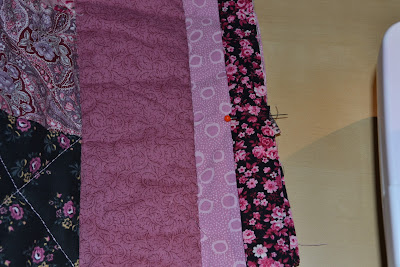Basically all I did was the quilting and I prepared and attached the binding. For most people who sew that would have probably been a much quicker turnaround, but I'm slow and had trouble completely focusing on one project (of course). BUT the important thing is it's done, Chelsea just picked it up and she loves it! YAY!
I thought I'd show you all how I attach the binding. I know there are a bunch of different ways to do it, and this is the way I have found works for me. I tried to take clear pictures along the way, but if anyone has any questions or something is unclear I'd be happy to try and make sense of it for you. =)
Okay, so hopefully you already have your quilt binding prepared. If not, go ahead and check out how I prepare my quilt binding .
Alright, so first what we're going to do is sew the raw edge of the binding onto the outer edge of the quilt top using a quarter inch seam. I usually like to put the start of the binding in the center of the "bottom" of the quilt. When you line the beginning up with the middle, leave an extra 5-6 inches tail or overhang.
Okay, so we did that, now we can start sewing. Again, sew with a quarter inch seam around, and don't start right in the middle of the bottom of the quilt or at the end of your binding. Again give yourself at least 5-6" and start sewing there. Be sure to back stitch at the beginning and end.
Stop sewing a quarter inch away from your first corner. Back stitch to secure.
Now, to make a mitered corner:
Take the tail or unsewn portion or the binding and fold it up to create a 45 degree angle.
Then, while maintaining that angle, fold the tail back onto itself and line it up with the un-sewn edge of the quilt.Make sure you pin it in place. It should look like the bottom photo if you pinch it up like I did. =)
Okay, so basically you then start sewing a quarter inch away from your mitered corner ( remember to back stitch at beginning and ends) using a quarter inch seam all the way around. Repeat the steps for the mitered corner at each corner.
When you get close to where you started sewing at the beginning, get ready to join the two ends. I have seen a few ways to do this, and I have found this way to be the least amount of hassle and with a good result.
Remember that in the beginning we had extra binding from the start of stitching and didn't start right in the middle? This is where all that becomes useful. Basically what we're going to do is tuck the end of the binding into the start of the binding.
You will have all this extra binding meeting up together. Don't panic, it's okay.
What you want to do is from the middle of the bottom area, trim up the beginning of the binding, leave about 1.5-2" extra from the middle of the bottom. Fold over the extra inch or two onto itself.
Now trim up the other end of the binding and tuck it inside the beginning binding. Pin, and sew to quilt top using a quarter inch seam, back stitching at beginning and end.
Cool beans, we did that. See how it looks pretty seamless already? Yay, go team us. Now I like to hand stitch that joining point and the mitered corners at the end to further secure them. Just a side note.
Okay, so now flip the quilt over and turn the binding over to the back side. If you are going to machine stitch it on, go ahead and pin all the way around the quilt making sure to cover up the stitches from joining the binding to the front.
Then, from the front, "stitch in the ditch" all the way around, back stitching and beginning and end. Be sure to take your time and check frequently that you are in fact catching the back of the binding.
OR- you could hand stitch the binding to the back of the quilt. This, of course will take longer, but will probably leave a more polished and professional finish to your quilt. I have not yet used this method, so I really can't comment too much on it. Make sure you tack down your mitered corners and the joining point of the binding.
Taa Daaaa! We're finished.
I hope you enjoyed this little how-to. If there's anything that you didn't understand please let me know and I'll try my best to better explain it. =)
















No comments:
Post a Comment